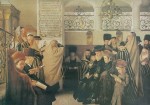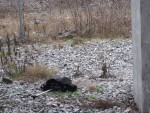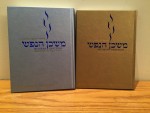Until this summer’s drought, most Vancouverites would have prayed for weather that made their umbrellas unnecessary. These High Holidays, however, many of us will be joining more wholeheartedly in the prayer for rain. (photo by Cynthia Ramsay)
I never gave much thought to the significance of rain until I moved to Miami. Rabbis in Miami face the High Holiday season with more than the usual rabbinic anxiety. In South Florida, the High Holiday season coincides with hurricane season. In the last several years of Florida living, I have reflected often on the ways in which Judaism invests rain with religious meaning. Prayers for rain mark the culmination of the High Holiday season.
The land of Israel is known as the land “flowing with milk and honey.” However, Israel is not a land flowing with water. The limited resource of water in the Holy Land is a central feature of biblical theology. Rain in the Promised Land plays an essential role in the covenantal relationship between God and the Jewish people.
Deuteronomy explains the unique spiritual essence of precipitation in the land of Israel. Unlike Egypt, where the water comes up from one’s feet, Israel is a land where people must look to the heavens for rain. In Egypt, it was easy to fall into idolatrous practices. The natural abundance of water from the Nile made the Egyptians worship the products of their own hands. However, this spiritual shortcoming is prevented in a land where the natural resources are scarce. The need to look heavenward for rain and the need to pray for rain continually remind the Israelites of God’s involvement and concern for our livelihood. “It is a land which the Lord your God looks after, on which the Lord your God always keeps His eye, from year’s beginning to year’s end.” (Deuteronomy 11:10)
God’s responsibility for dispensing rain in the land of Israel is a central aspect of our covenantal identity. Not only do we live in a land that depends upon God for rain, but God’s gift of rain will be conditioned upon the fulfilment of our covenantal duties. Every day, twice a day, the Jewish people express our love and commitment to God in the words of the Sh’ma.
The second paragraph of the Sh’ma is an excerpt from Deuteronomy about the connection between our covenant with God and rain: “If, then, you obey the commandments that I enjoin upon you this day, loving the Lord your God and serving Him with all your heart and soul, I will grant the rain for your land in season…. Take care not to be lured away to serve other gods and bow to them; for the Lord’s anger will flare up against you, and He will shut up the skies so that there will be no rain….” (11:13)
The notion that the natural events of weather are reflective of God’s covenantal relationship with the Jewish people is a difficult one for many modern Jews. This paragraph is omitted in the version of the Sh’ma found in Reform prayer books.
However, the theological lessons of Deuteronomy can be teased out without adopting a literal reading of the text. Is it true that rain falls in Israel only if the Jewish people are observing all the commandments? Or perhaps our daily recitation of the Sh’ma establishes a consciousness about our fragility in a world where we cannot control the elements. In such a world of limited human power, we recognize that our lives are a gift from God. The recognition of our dependence leads to a sense of responsibility. The Jewish response to the precarious nature of life is to find meaning and purpose in commandedness. Rain in the land of Israel serves as a reminder of our covenant with God.
According to the Torah, the scarcity of rain in Israel is a spiritual safeguard. As the Israelite nation prepares to enter the Promised Land, the Book of Deuteronomy is consumed with a fear regarding the spiritual danger of sovereignty. Once we leave the desert and settle in our own land, we might forget about God’s role in our lives:
“When you have eaten your fill and have built fine houses to live in … and everything you own has prospered, beware lest your heart grow haughty and you forget the Lord your God … who led you through the great and terrible wilderness … a parched land with no water in it, who brought forth water for you from the flinty rock; who fed you in the wilderness with manna … and you say to yourselves, ‘My own power and the might of my own hand have won this wealth for me.’ Remember that it is the Lord your God who gives you the power to prosper.” (8:12-18)
For 40 years, the Israelites depended upon God for sustenance in a hostile environment lacking natural resources. That dependency cultivated an intimacy with God and an appreciation for our human weakness. However, when we enter the Promised Land, and we build our own houses and plant our own crops, we might grow arrogant and distant from God.
According to the medieval commentator Rashbam, it is precisely because of this threat that God instituted the festival of Sukkot at the time of the harvest, when we are most likely to glorify in our material success:
“Therefore, the people leave their houses, which are full of everything good at the season of the ingathering, and dwell in booths, as a reminder of those who had no possessions in the wilderness and no houses in which to live. For this reason, the Holy One established the festival of Sukkot … that the people should not be proud of their well-furnished houses.” (Rashbam, Commentary on Leviticus 23:43)
The purpose of dwelling in the sukkah, according to Rashbam, is to remind us of our vulnerability in the desert and to return us to that ideal spiritual state of humility and dependency. Without a yearly reminder of our frail human condition, we might grow too haughty in our own land and begin to worship the power of our own hands.
The festival of Sukkot culminates in the holiday of Shemini Atzeret. This obscure holiday embodies one main ritual – tefilat geshem, the prayer for rain. Focusing on the uncertainty of rain is the perfect conclusion to the High Holiday season. One of the recurring themes of the High Holidays is the nature of human mortality. As human beings, our existence is vulnerable and ephemeral. Will we even be here next year? “Who shall live, and who shall die … who by fire and who by water?” This yearly reminder of our fragile human condition is meant to jolt us out of our complacency, to inspire us in our search for greater meaning and purpose in life.
This central High Holiday motif finds its dramatic finale in tefilat geshem, as the cantor comes forward during the musaf prayers, dressed in a kittel, the white burial shroud, and invoking Yom Kippur melodies. We conclude the spiritual marathon of the High Holidays with prayers for rain, humbled by the awareness of our fragility and our dependence upon God for sustenance and survival. As we pray for rain, we also rejoice in the notion that God cares for us and keeps His eyes on us, from year’s beginning to year’s end. Rain will be a daily reminder of our human limitations and the greater meaning and purpose we can find in accepting a covenant with God.
On this Shemini Atzeret, may our prayers for rain remind us of our vulnerabilities and our responsibilities to God, “Who causes the wind to blow and the rain to fall.”
This article was originally published in the Jewish Week and can be found on the Shalom Hartman Institute website, hartman.org.il. It is reprinted with permission.






